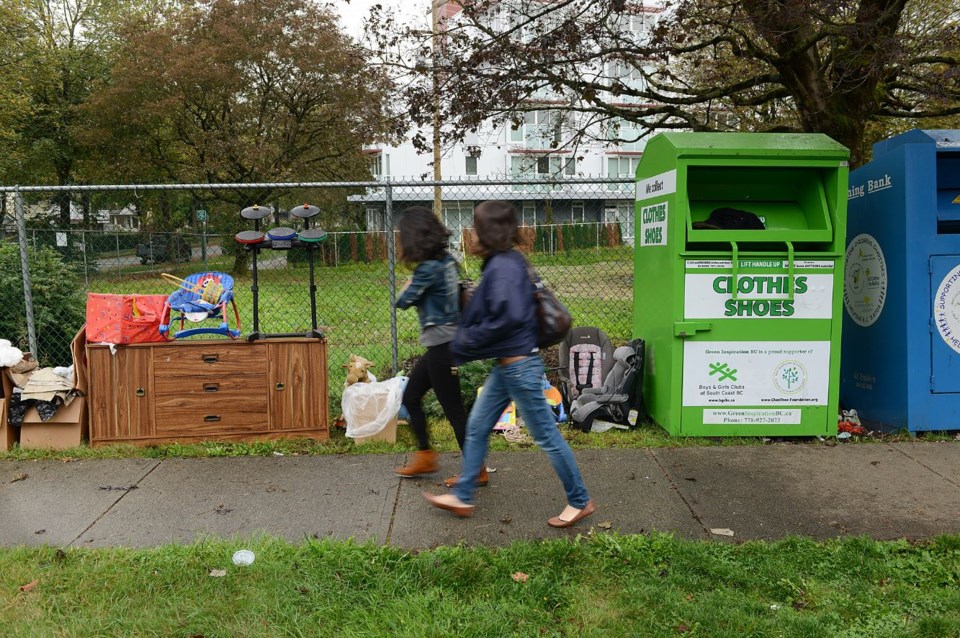Her name was Sveta. She was the 39-year-old woman whose tragic death took place just weeks ago as a result of getting stuck head first in the chute of a clothing bin stationed near West Point Grey Community Centre.
We know Sveta’s name because of a series of handwritten messages her devastated companion, Michael, left in a notebook set out by the community centre to memorialize her passing. The Vancouver Sun reported that Michael camped with Sveta nearby in a small tent, the scabs on his legs indicating a difficult life on the street.
Sveta’s accidental death is one of several local fatalities in recent years resulting from people becoming stuck in the ubiquitous metal bins. Much more often, however, first responders are sent to rescue those who get an arm, neck, torso or their entire body trapped in the bin.
Some are calling to make the bins safer. I think we must ask whether the bins’ downsides outweigh the benefits.
Organizations such as Diabetes Canada, InclusionBC, Developmental Disabilities Association and even Vancouver Fire Fighters use the bins to fund charitable causes. Clothing and book donation bins are often owned by for-profit companies that license a charity’s name in exchange for partial proceeds from what is collected.
If you have one of these bins in your neighbourhood, you know them for the eyesore they quickly become. The bins are visited by those who scavenge the clothing and dump what they do not want on the ground beside it.
If the container is overflowing, count on finding bags of T-shirts, jeans, old socks — even furniture and mattresses —piled up beside it. The resulting mess around these bins triggers hundreds of 3-1-1 calls each year, for which taxpayers pick up the tab.
Items picked out of the bins do not only help clothe the needy. Unlicensed “pop-up” vendors will re-sell the clothes on a busy sidewalk. What does not sell is often thrown away. Take a look at the clothing articles dumped into the Grandview Cut near Commercial Drive.
The City of Burnaby has already chosen to ban these bins from public property. Richmond still has the bins, but with restrictions in place. Vancouver has dragged its feet on regulating them.
According to a Metro Vancouver study, an average person in the region throws out an astounding 19 kilograms, or 42 pounds, of textiles every year. The bins have become a convenience for landfill operators who do not want to bear the cost of diverting textiles away from the waste stream.
It should be no surprise to our cities why so many articles of clothing are winding up in the dump — people are buying more stuff. Adjusting for inflation, replacing garments has never been more affordable than it is today.
There are multiple reports on the damage these receptacles are doing by allowing clothing articles to be collected, baled and delivered in shipping containers to far flung developing countries.
Textile industry watchdogs claim that cities in East Africa and Central America have especially felt the brunt of this clothing being dumped on them. The flood has helped to wipe out indigenous clothing manufacturers and the jobs that go with them. Much of the clothing winds up in landfills overseas.
The myth about textiles is that they can be easily recycled. In fact, reusing fabrics is costly and difficult, which is why only one per cent ever makes it into new articles of clothing. A slightly larger percentage finds its way into carpet padding or is shredded to make insulation products.
There are alternatives for donating clothing that do not pose a safety risk. Our household drops off clean clothes at a Salvation Army depot during business hours. However, only about 10 per cent of the clothing donated to these places is considered good enough to be resold in a retail store.
In light of Sveta’s death and many others, we should be thinking long and hard if these bins are a risk to public safety.
How the charities recoup lost revenue is another question. The practicalities of dealing with textiles in the waste stream is not something governments should outsource either.
Regardless of how you look at this issue, the status quo is not an option.
@MikeKlassen
mike@mikeklassen.net



